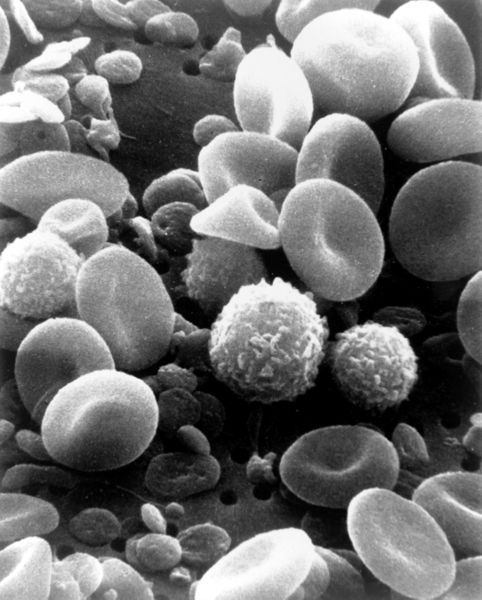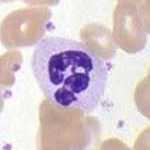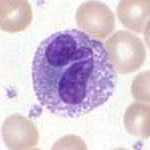Innate immune system
Editor-In-Chief: C. Michael Gibson, M.S., M.D. [1]
Overview
The innate immune system comprises the cells and mechanisms that defend the host from infection by other organisms, in a non-specific manner. This means that the cells of the innate system recognize, and respond to, pathogens in a generic way, but unlike the adaptive immune system, it does not confer long-lasting or protective immunity to the host.[1] Innate immune systems provide immediate defense against infection, and are found in all classes of plant and animal life.
Functions
The innate system is thought to constitute an evolutionarily older defense strategy, and is the dominant immune system found in plants, fungi, insects, and in primitive multicellular organisms (see Other forms of innate immunity).[2]
The major functions of the vertebrate innate immune system include:
- Recruiting immune cells to sites of infection and inflammation, through the production of chemical factors, including specialized chemical mediators, called cytokines.
- Activation of the complement cascade to identify bacteria, activate cells and to promote clearance of dead cells or antibody complexes.
- The identification and removal of foreign substances present in organs, tissues, the blood and lymph, by specialized white blood cells.
- Activation of the adaptive immune system through a process known as antigen presentation.
Inflammation
Inflammation is one of the first responses of the immune system to infection or irritation. Inflammation is stimulated by chemical factors released by injured cells and serves to establish a physical barrier against the spread of infection, and to promote healing of any damaged tissue following the clearance of pathogens.[3]
Chemical factors produced during inflammation (histamine, bradykinin, serotonin, leukotrienes) sensitize pain receptors, cause vasodilation of the blood vessels at the scene, and attract phagocytes, especially neutrophils.[3] Neutrophils then trigger other parts of the immune system by releasing factors that summon other leukocytes and lymphocytes. The inflammatory response is characterized by the following symptom quintet: redness (rubor), heat (calor), swelling (tumor), pain (dolor) and possible dysfunction of the organs or tissues involved (functio laesa).
Complement system
The complement system is a biochemical cascade of the immune system that helps, or “complements”, the ability of antibodies to clear pathogens or mark them for destruction by other cells. The cascade is composed of many plasma proteins, synthesized in the liver, primarily by hepatocytes. The proteins work together to:
- trigger the recruitment of inflammatory cells.
- "tag" pathogens for destruction by other cells by opsonizing, or coating, the surface of the pathogen.
- disrupt the plasma membrane of an infected cell, resulting in cytolysis of the infected cell, causing the death of the pathogen.
- rid the body of neutralized antigen-antibody complexes.
Elements of the complement cascade can be found in many species evolutionarily older than mammals including plants, birds, fish and some species of invertebrates.[4]
Cells of the innate immune response

All white blood cells (WBC) are known as leukocytes. Leukocytes are different from other cells of the body in that they are not tightly associated with a particular organ or tissue; thus, they function similar to independent, single-celled organisms. Leukocytes are able to move freely and interact and capture cellular debris, foreign particles, or invading microorganisms. Unlike many other cells in the body, most innate immune leukocytes cannot divide or reproduce on their own, but are the products of pluripotent hematopoietic stem cells present in the bone marrow.[1]
The innate leukocytes include: Natural killer cells, mast cells, eosinophils, basophils; and the phagocytic cells including macrophages, neutrophils and dendritic cells, and function within the immune system by identifying and eliminating pathogens that might cause infection.[2]
Mast cells
Mast cells are a type of innate immune cell that resides in the connective tissue and in the mucous membranes, and are intimately associated with defense against pathogens, wound healing, but are also often associated with allergy and anaphylaxis.[3] When activated, mast cells rapidly release characteristic granules, rich in histamine and heparin, along with various hormonal mediators, and chemokines, or chemotactic cytokines into the environment. Histamine dilates blood vessels, causing the characteristic signs of inflammation, and recruits neutrophils and macrophages.[3]
Phagocytes
The word 'phagocyte' literally means 'eating cell'. These are immune cells that engulf, i.e. phagocytose, pathogens or particles. To engulf a particle or pathogen, a phagocyte extends portions of its plasma membrane, wrapping the membrane around the particle until it is enveloped (i.e. the particle is now inside the cell). Once inside the cell, the invading pathogen is contained inside an endosome which merges with a lysosome.[2] The lysosome contains enzymes and acids that kill and digest the particle or organism. Phagocytes generally patrol the body searching for pathogens, but are also able to react to a group of highly specialized molecular signals produced by other cells, called cytokines. The phagocytic cells of the immune system include macrophages, neutrophils, and dendritic cells.
Phagocytosis of the hosts’ own cells is common as part of regular tissue development and maintenance. When host cells die, either internally induced by processes involving programmed cell death (also called apoptosis), or caused by cell injury due to a bacterial or viral infection, phagocytic cells are responsible for their removal from the affected site.[1] By helping to remove dead cells preceding growth and development of new healthy cells, phagocytosis is an important part of the healing process following tissue injury.

Macrophages
Macrophages, from the Greek, meaning "large eating cell", are large phagocytic leukocytes, which are able to move outside of the vascular system by moving across the cell membrane of capillary vessels and entering the areas between cells in pursuit of invading pathogens. In tissues, organ-specific macrophages are differentiated from phagocytic cells present in the blood called monocytes. Macrophages are the most efficient phagocytes, and can phagocytose substantial numbers of bacteria or other cells or microbes.[2] The binding of bacterial molecules to receptors on the surface of a macrophage triggers it to engulf and destroy the bacteria through the generation of a “respiratory burst”, causing the release of reactive oxygen species. Pathogens also stimulate the macrophage to produce chemokines, which summons other cells to the site of infection.[2]
Neutrophils

Neutrophils, along with two other cell types; eosinophils and basophils (see below), are known as granulocytes due to the presence of granules in their cytoplasm, or as polymorphonuclear cells (PMNs) due to their distinctive lobed nuclei. Neutrophil granules contain a variety of toxic substances that kill or inhibit growth of bacteria and fungi. Similar to macrophages, neutrophils attack pathogens by activating a "respiratory burst". The main products of the neutrophil respiratory burst are strong oxidizing agents including hydrogen peroxide, free oxygen radicals and hypochlorite. Neutrophils are the most abundant type of phagocyte, normally representing 50 to 60% of the total circulating leukocytes, and are usually the first cells to arrive at the site of an infection.[3] The bone marrow of a normal healthy adult produces more than 100 billion neutrophils per day, and more than 10 times that many per day during acute inflammation.[3]
Dendritic cells
Dendritic cells (DC) are phagocytic cells present in tissues that are in contact with the external environment, mainly the skin (where they are often called Langerhans cells), and the inner mucosal lining of the nose, lungs, stomach and intestines.[1] They are named for their resemblance to neuronal dendrites, but dendritic cells are not connected to the nervous system. Dendritic cells are very important in the process of antigen presentation, and serve as a link between the innate and adaptive immune systems.

Basophils and Eosinophils
Basophils and Eosinophils are cells related to the neutrophil (see above). When activated by a pathogen encounter, basophils releasing histamine are important in defense against parasites, and play a role in allergic reactions (such as asthma).[2] Upon activation, eosinophils secrete a range of highly toxic proteins and free radicals that are highly effective in killing bacteria and parasites, but are also responsible for tissue damage occurring during allergic reactions. Activation and toxin release by eosinophils is therefore tightly regulated to prevent any inappropriate tissue destruction.[3]
Natural killer cells
Natural killer cells, or NK cells, are a component of the innate immune system. NK cells attack host cells that have been infected by microbes, but do not directly attack invading microbes. For example, NK cells attack and destroy tumor cells, and virally infected cells, through a process known as "missing-self". This term describes cells with low levels of a cell-surface marker called MHC I (major histocompatibility complex)—a situation which can arise in viral infections of host cells.[4] They were named "natural killer" because of the initial notion that they do not require activation in order to kill cells that are "missing self."
γδ T cells
Like other 'unconventional' T cell subsets bearing invariant T cell receptors (TCRs), such as CD1d-restricted Natural Killer T cells, γδ T cells exhibit characteristics that place them at the border between innate and adaptive immunity. One on hand, γδ T cells may be considered a component of adaptive immunity in that they rearrange TCR genes to produce junctional diversity and develop a memory phenotype. However, the various subsets may also be considered part of the innate immune system where a restricted TCR or NK receptors may be used as a pattern recognition receptor. For example, according to this paradigm, large numbers of Vγ9/Vδ2 T cells respond within hours to common molecules produced by microbes, and highly restricted intraepithelial Vδ1 T cells will respond to stressed epithelial cells.
Innate immune evasion
Cells of the innate immune system effectively prevent free growth of bacteria within the body; however, many pathogens have evolved mechanisms allowing them to evade the innate immune system.[5][6]
Evasion strategies that circumvent the innate immune system include intracellular replication, such as in Salmonella, or a protective capsule that prevents lysis by complement and by phagocytes, as in Mycobacterium tuberculosis.[7] Bacteroides species are normally commensal bacteria, making up a substantial portion of the mammalian gastrointestinal flora.[8] Some species (B. fragilis, for example) are opportunistic pathogens, causing infections of the peritoneal cavity. These species evade the immune system through inhibition of phagocytosis by affecting the receptors that phagocytes use to engulf bacteria or by mimicking host cells so that the immune system does not recognize them as foreign. Staphylococcus aureus inhibits the ability of the phagocyte to respond to chemokine signals. Other organisms such as M. tuberculosis, Streptococcus pyogenes and Bacillus anthracis utilize mechanisms that directly kill the phagocyte.
Bacteria and fungi may also form complex biofilms, providing protection from the cells and proteins of the immune system; recent studies indicate that such biofilms are present in many successful infections, including the chronic Pseudomonas aeruginosa and Burkholderia cenocepacia infections characteristic of cystic fibrosis.[9]
Other forms of innate immunity
Host defense in prokaryotes
Bacteria (and perhaps other prokaryotic organisms), utilize a unique defense mechanism, called the restriction modification system to protect themselves from pathogens, such as bacteriophages. In this system, bacteria produce enzymes, called restriction endonucleases, that attack and destroy specific regions of the viral DNA of invading bacteriophages. Methylation of the host's own DNA marks it as "self" and prevents it from being attacked by endonucleases.[10] Restriction endonucleases and the restriction modification system exist exclusively in prokaryotes.
Host defense in invertebrates
Invertebrates do not possess lymphocytes or an antibody-based humoral immune system, and it is likely that a multicomponent, adaptive immune system arose with the first vertebrates.[11] Nevertheless, invertebrates possess mechanisms that appear to be precursors of these aspects of vertebrate immunity. Pattern recognition receptors are proteins used by nearly all organisms to identify molecules associated with microbial pathogens. Toll-like receptors are a major class of pattern recognition receptor, that exists in all coelomates (animals with a body-cavity), including humans.[12] The complement system, as discussed above, is a biochemical cascade of the immune system that helps clear pathogens from an organism, and exists in most forms of life. Some invertebrates, including various insects, crabs, and worms utilize a modified form of the complement response known as the prophenoloxidase (proPO) system.[11]
Antimicrobial peptides are an evolutionarily conserved component of the innate immune response found among all classes of life and represent the main form of invertebrate systemic immunity. Several species of insect produce antimicrobial peptides known as defensins and cecropins.
Host defense in plants
Members of every class of pathogen which infect humans also infect plants. Although the exact pathogenic species vary with the infected species, bacteria, fungi, viruses, nematodes and insects can all cause plant disease. As with animals, plants attacked by insects or other pathogens use a set of complex metabolic responses that lead to the formation of defensive chemical compounds which fight infection or make the plant less attractive to insects and other herbivores.[13] (see: plant defense against herbivory).
Like invertebrates, plants neither generate antibody or T-cell responses, nor do they possess mobile cells that detect and attack pathogens. In addition, in case of infection, parts of some plants are treated as disposable and replaceable, in ways that very few animals do. Walling off or discarding a part of a plant help stop spread of an infection.[13]
Most plant immune responses involve systemic chemical signals sent throughout a plant. Plants use pattern-recognition receptors to identify pathogens and to start a basal response, which produces chemical signals that aid in warding off infection. When a part of a plant becomes infected with a microbial or viral pathogen, in case of an incompatible interaction triggered by specific elicitors, the plant produces a localized hypersensitive response (HR), in which cells at the site of infection undergo rapid programmed cell death to prevent the spread of the disease to other parts of the plant. HR has some similarities to animal pyroptosis, such as a requirement of caspase-1-like proteolytic activity of VPEγ, a cysteine protease, that regulates cell disassembly during cell death.[14]
"Resistance" (R) proteins, encoded by R genes, are widely present in plants and detect pathogens. These proteins contain domains similar to the NOD Like Receptors and Toll-like receptors utilized in animal innate immunity. Systemic acquired resistance (SAR) is a type of defensive response that renders the entire plant resistant to a broad spectrum of infectious agents. SAR involves the production of chemical messengers, such as salicylic acid or jasmonic acid. Some of these travel through the plant and signal other cells to produce defensive compounds to protect uninfected parts, e.g., leaves. Salicylic acid itself, although indispensable for expression of SAR, is not the translocated signal responsible for the systemic response. Recent evidence indicates a role for jasmonates in transmission of the signal to distal portions of the plant. RNA silencing mechanisms are also important in the plant systemic response as they can block virus replication.[15] The jasmonic acid response, is stimulated in leaves damaged by insects, and involves the production of methyl jasmonate.[13]
See also
References
- ↑ 1.0 1.1 1.2 1.3 Alberts, Bruce (2002). Molecular Biology of the Cell; Fourth Edition. New York and London: Garland Science. ISBN 0-8153-3218-1. Unknown parameter
|coauthors=ignored (help) - ↑ 2.0 2.1 2.2 2.3 2.4 2.5 Janeway, Charles (2001). Immunobiology; Fifth Edition. New York and London: Garland Science. ISBN 0-8153-4101-6. Unknown parameter
|coauthors=ignored (help). - ↑ 3.0 3.1 3.2 3.3 3.4 3.5 3.6 Stvrtinová, Viera (1995). Inflammation and Fever from Pathophysiology: Principles of Disease. Computing Centre, Slovak Academy of Sciences: Academic Electronic Press. Unknown parameter
|coauthors=ignored (help) - ↑ 4.0 4.1 Janeway CA, Jr.; et al. (2005). Immunobiology (6th ed. ed.). Garland Science. ISBN 0-443-07310-4.
- ↑ Kennedy, Alan. "Immune Evasion by bacteria".
- ↑ Finlay B, McFadden G (2006). "Anti-immunology: evasion of the host immune system by bacterial and viral pathogens". Cell. 124 (4): 767–82. PMID 16497587.
- ↑ Finlay B, Falkow S (1997). "Common themes in microbial pathogenicity revisited" (PDF). Microbiol Mol Biol Rev. 61 (2): 136–69. PMID 9184008.
- ↑ Dorland WAN (editor) (2003). Dorland's Illustrated Medical Dictionary (30th ed.). W.B. Saunders. ISBN 0-7216-0146-4.
- ↑ Kobayashi H (2005). "Airway biofilms: implications for pathogenesis and therapy of respiratory tract infections". Treat Respir Med. 4 (4): 241–53. PMID 16086598.
- ↑ Restriction Enzymes Access Excellence Classic Collection Background Paper.
- ↑ 11.0 11.1 Beck, Gregory and Habicht, Gail S. Immunity and the Invertebrates Scientific American. November 1996:60-66.
- ↑ Imler JL, Hoffmann JA. (2001) Toll receptors in innate immunity. Trends Cell Biol. Jul;11(7):304-11. Review. PMID 11413042
- ↑ 13.0 13.1 13.2 Schneider, David (2005) Plant immune responses Stanford University Department of Microbiology and Immunology.
- ↑ Rojo, E.; et al. (2004). "VPEgamma exhibits a caspase-like activity that contributes to defense against pathogens". Curr Biol. 14 (21): 1897–1906. PMID 15530390.
- ↑ Baulcombe D (2004). "RNA silencing in plants". Nature. 431 (7006): 356–63. PMID 15372043.